Line Drawing: A Guide for Art Students
Last Updated on September 1, 2023
When we first picked up a pen or pencil and started making marks on paper, we began with line. Whether self-taught, through trial and error, or guided by others, we learned how line defines form, creates structure, divides a frame, traces contour, creates tonal variation (cross-hatching, for example) and leads the eye from one part of a work to another. Initially a mechanism for getting outlines onto paper – identifying edges – we begin to applaud lines for their own merit: celebrate their presence…whether a quiet flick of charcoal on paper or a streak of graphite.

This article contains exercises for Art students who wish to produce contour line drawings, cross contour drawings, blind drawings and other types of line drawings. It is a teaching aid for high school Art students and includes classroom activities, a free downloadable PDF worksheet and inspirational artist drawings.

Blind Contour Drawing
Definition : A blind contour drawing contains lines that are drawn without ever looking at the piece of paper. This forces you to study a scene closely, observing every shape and edge with your eyes, as your hand mimics these on paper. The aim is not to produce a realistic artwork, but rather to strengthen the connection between eyes, hand and brain: a reminder that, when drawing, you must first learn to see.
Blind Drawing Exercises : Blind drawing is an excellent way to start a high school Fine Art programme. Drawing wobbly lines that bear little resemblance to the chosen object is relaxing and stress-free. Often, a classroom bubbles with laughter at the unexpected results. Blind drawing stretches the arms and soul; eases you into observational drawing without fear.
READ NEXT: How to make an artist website (and why you need one)
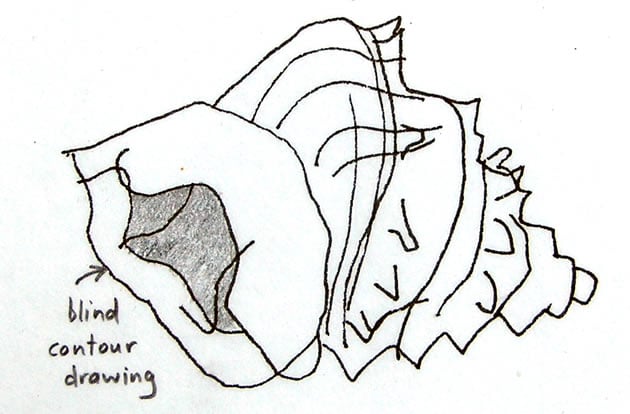
Gesture Drawing / Timed Drawing / Movement Drawing
Definition : A gesture drawing is completed quickly – often in short timed durations, such as 20, 30, 60 or 90 seconds – using fast, expressive lines. Gesture drawings capture basic forms and proportions – the emotion and essence of a subject – without focusing on detail. Due to their rapid completion, they are a great way to record movement and action, as well as increase your drawing speed, confidence and intuitive mark-making skill. Gesture drawings are best completed with smooth, easily applied mediums (chunky graphite pencils, charcoal sticks, pastels, soft brushes dipped in Indian ink, for example), without the use of an eraser. They are often completed on large, inexpensive sheets of paper, where you can move your arm fluidly, be bold with mark-making, and not worry about mistakes. As with blind drawings, gesture drawing is an ideal warm-up activity.
Gesture Drawing Exercises : When you begin investigating your subject matter in the initial phase of a high school Art programme, it can be helpful to make several first-hand gestural drawings. The best of these can be selected for your final portfolio (taking advantage of a photocopier or digital camera to reduce in size, if necessary). A small still life scene can be depicted just as easily as a large moving form.
A gesture drawing by Rembrandt Harmenszoon van Rijn :
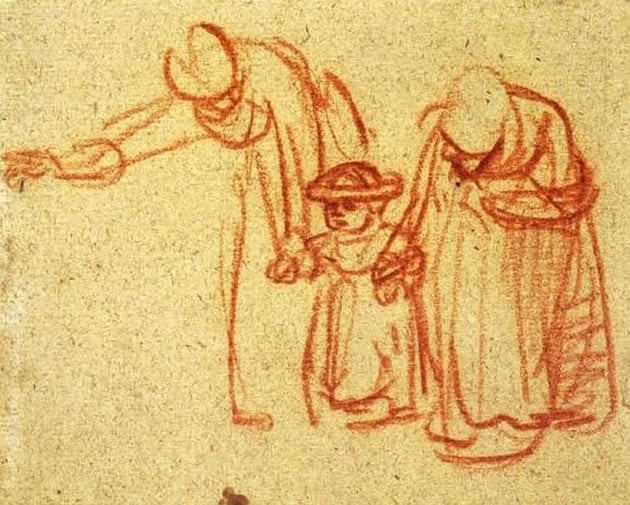
A gestural figure drawing by Chelsea Stebar :

Continuous Line Drawing
Definition : A continuous line drawing is produced without ever lifting the drawing instrument from the page. This means that, in addition to outlines and internal shapes, the pencil must move back and forth across the surface of the paper, with lines doubling back on each other, so that the drawing is one free-flowing, unbroken line. To avoid the temptation to erase lines, it can be helpful to complete a continuous line drawing with an ink pen, varying the line weight, as needed, to indicate perspective and areas of light and shadow. Like the drawing methods described above, this drawing method develops confidence and drawing speed, and encourages your eyes and hand and brain to work together. Continuous line drawings work best with in-depth observation of your subject, without interference from your thinking mind. According to Smithsonian Studio Arts :
…continuous line drawing is actually a very powerful way to create a piece that is both hard edged and fluid, representational and abstract, rational and emotional all in one.
Continuous Line Drawing Exercises : This drawing method is great for sketchbooks and drawing from life. It can be an excellent starter activity, with drawings completed on large, inexpensive paper that can be scanned / edited / cropped and used in other ways within your projects.
An A Level Art sketchbook page by Lucy Feng from Hereford Sixth Form College, Herefordshire, UK:
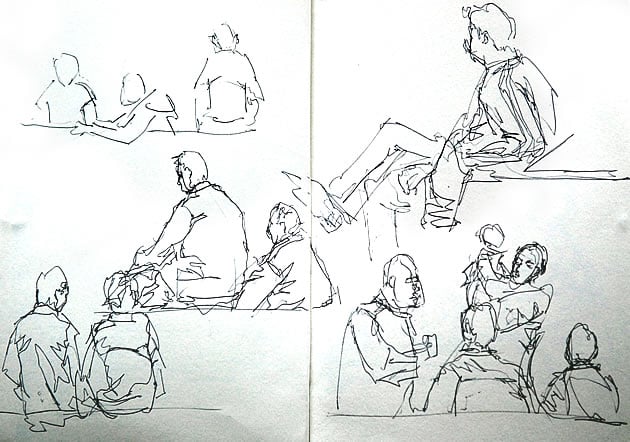
Contour drawing
Definition: A contour drawing shows the outlines, shapes and edges of a scene, but omits fine detail, surface texture, colour and tone (‘contour’ is French for ‘outline’). According to Wikipedia :
The purpose of contour drawing is to emphasize the mass and volume of the subject rather than the detail; the focus is on the outlined shape of the subject and not the minor details.
The illusion of three-dimensional form, space and distance can be conveyed in a contour drawing through the use of varied line-weight (darker lines in the foreground / paler lines in the distance) and perspective.
Contour Drawing Exercises : Using line alone eliminates the challenge of applying tone, colour and mediums; and instead focuses attention solely upon shape and proportion. After completing warm-up activities such as blind and gesture drawings, slower, more formal contour drawings can be an excellent way to begin more realistic representations of your subject matter. Used intermittently throughout projects, contour drawings can also be helpful for the student who needs to work faster .
A contour drawing by Ultima Thule :
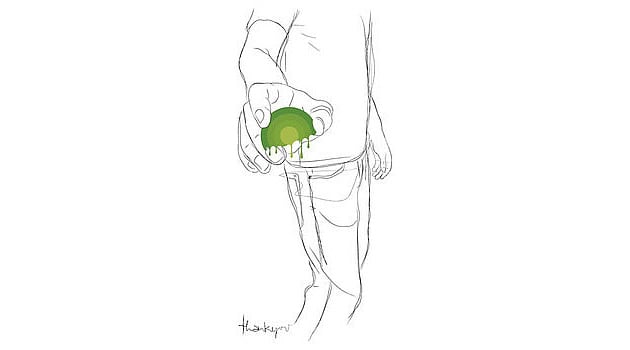
Cross contour drawing
Definition : A cross contour drawing contains parallel lines that run across the surface of an object (or radiate from a central point), such as those that appear on a topographical map or a digital wireframe. The lines can run at any appropriate angle (sometimes at multiple angles) and may continue across objects and into the background. Cross contour drawings typically follow the rules of perspective, with lines drawn closer together in the distance and further apart in the foreground. In this type of drawing, the illusion of three-dimensional volume is created entirely with line.
Cross Contour Drawing Exercises : This is an excellent way to gain familiarity with the volumes and three-dimensional forms in your project, producing analytical cross contour drawings that are suitable for sketchbooks or early preparatory sheets.
Cross contour drawing of a shell by Matt Louscher :

Cross contour hand drawings by (from left) Mathew Young, Ryan Acks and Lea Dallaglio while studying at the San Jose State University , Department of Art and Art History:

Cross contour drawings by Daniel Servin (left) and Alfred Manzano, completed while studying AP Studio Art at Mt Eden High School in Hayward, California, USA:

A wireframe contour drawing exercise by Year 9 student Seonmin Lee from ACG Parnell College , Auckland, New Zealand:
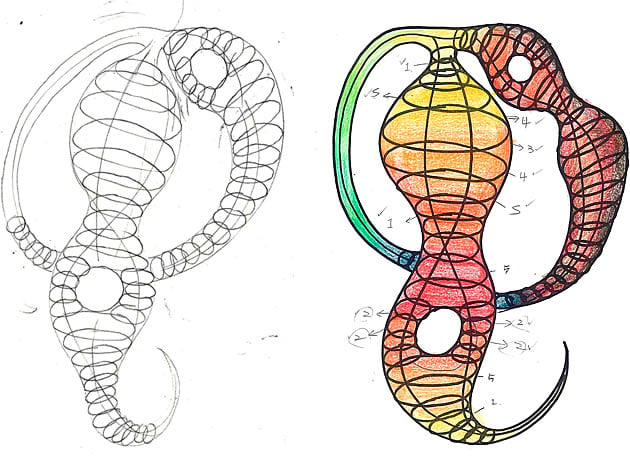
Planar analysis drawing
Definition : A planar analysis drawing simplifies complex curved surfaces into flat planes, using straight lines. This process helps students to think about the underlying structure of objects and results in an analytical drawing, that is rather mechanical in appearance.
Planar Analysis Drawing Activity : This can be a great introductory drawing exercise, especially if you are moving towards Cubism or abstracting scenes into geometric form.
A planar analysis portrait completed by a student of Cat Normoyle :
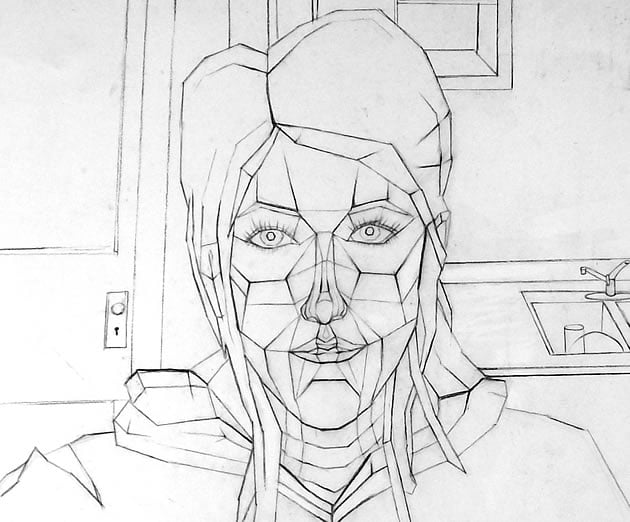
Wire sculpture drawings
Definition : Wire can be cut and bent into shapes with pliers to create three-dimensional ‘drawings’, often resulting in a work filled with flowing, curved lines. These wire sculptures can be attached to a two-dimensional frame or a flat surface, hung in the air, or be left free-standing, changing in appearance as a viewer moves around the room. Due to their flexible nature, wire sculptures often move slightly in the wind, adding an extra interactive element to the work.
Wire Sculpture Line Drawing Exercise : This is an excellent activity for middle school students and for high school students, if it relates specifically to your project (and does not interfere with postage requirements, for those who need to post work away for assessment). Small wire experiments, using light-weight wire, can also be mounted to sketchbook pages.
Wire sculptures completed by the students of Amy Bonner Oliveri from Allendale Columbia School, Rochester, New York, USA:
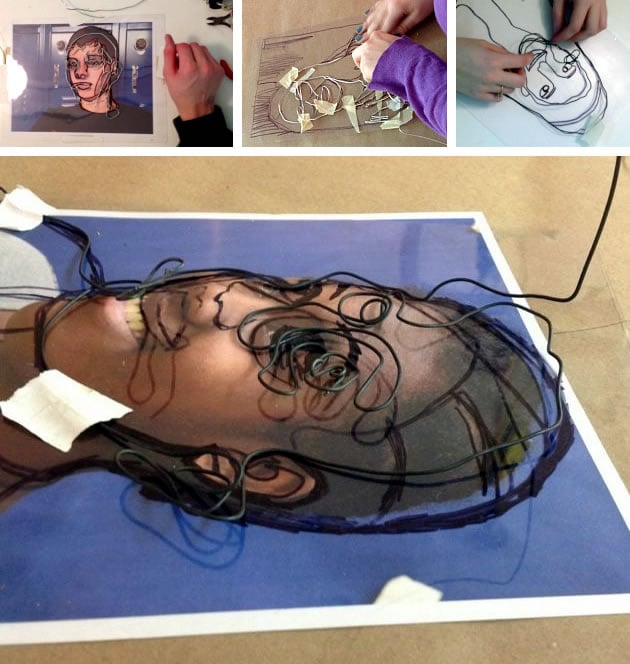

Hatching, cross hatching, and other line techniques
As well as representing contours, line can also be used to apply tone (light and shadow) to a drawing. This can be done by altering the:
- Gap between the lines
- Lightness / darkness of the line
- Thickness of the line
There are many line techniques can be used to create tone, as illustrated in the worksheet below. Common techniques include:
- Small dashes
- Hatching (long, parallel lines on an angle)
- Cross-hatching (parallel lines at right angles)
- Stippling (dots)
- Small crosses
- Small circles
The angle that these techniques are applied may remain constant within a drawing, or it may change in response to the angle and direction of the forms. For example, cross-hatching may flow around the surface of an object in a similar direction as cross contour lines. These techniques are also a great way to create the illusion of texture (see our article about observational drawings ).
Line Techniques Worksheet : The worksheet below has been provided by the Student Art Guide for classroom use only and may be issued freely to students (credited to studentartguide.com), as well as shared via the social media buttons at the bottom of this page. It may not be published online or shared or distributed in any other way, as per our terms and conditions . The full size printable worksheet is available by clicking the PDF link below. This worksheet is suitable for middle school students, or senior students who have not had prior experience with line techniques.
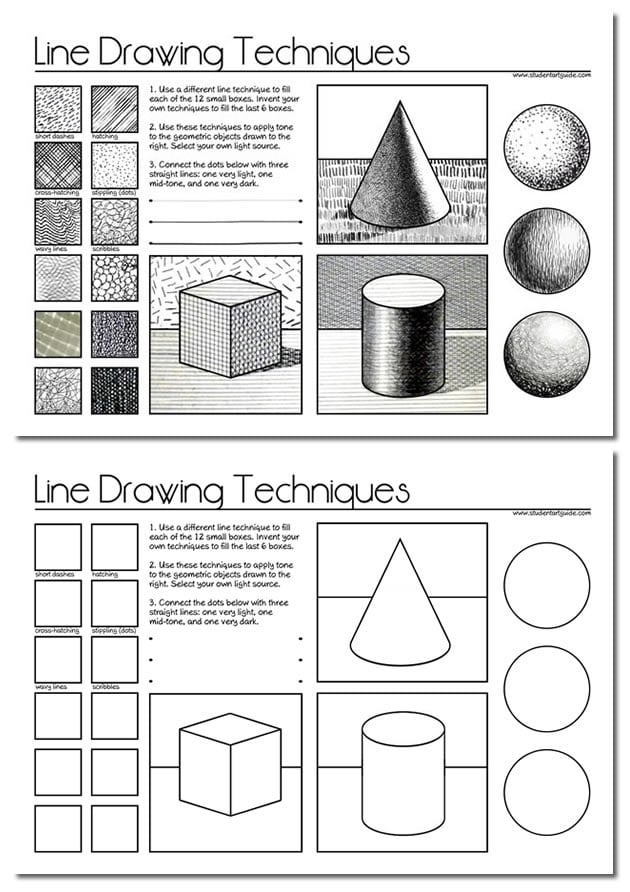
Click here to open the full size worksheet as a printable PDF .
An Indian Ink still life drawing by Kirana Intraroon, completed while in Year 10 at ACG Strathallan College , Auckland, New Zealand:

An A* GCSE Art sketchbook page by Samantha Li :
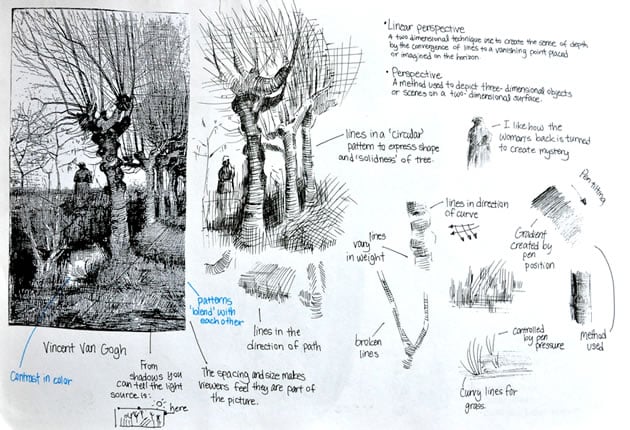
A final GCSE Art piece by Hannah Armstrong :

Artist line drawings
Here is a collection of line drawings from famous and less well known artists, to inspire high school Art students and teachers. This section is continually updated. Enjoy!
Pablo Picasso :

Andy Warhol :
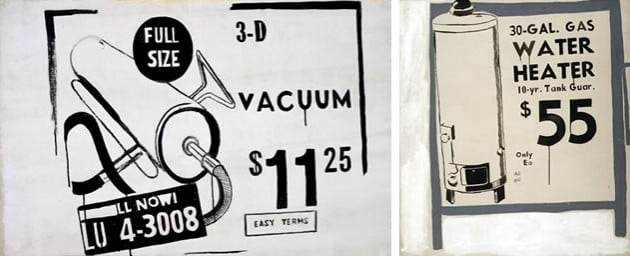
David Hockney :

Vincent van Gogh :

Leonardo da Vinci :
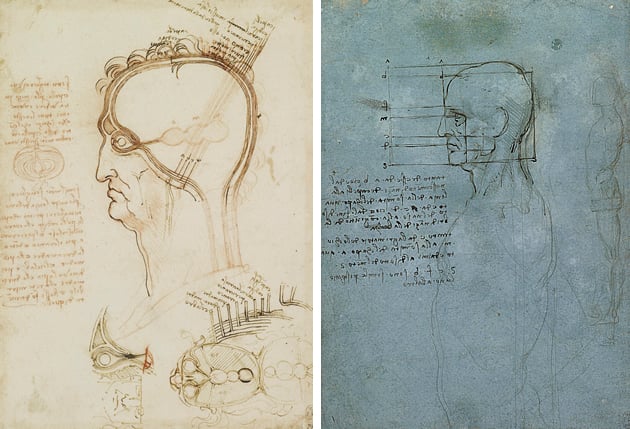
Aaron Earley :

Peter Root :

Maurizio Anzeri

Karolina Cummings :

Daniel Mathers

Roz McQuillan :

Wang Tzu-Ting :

Nina Smart :
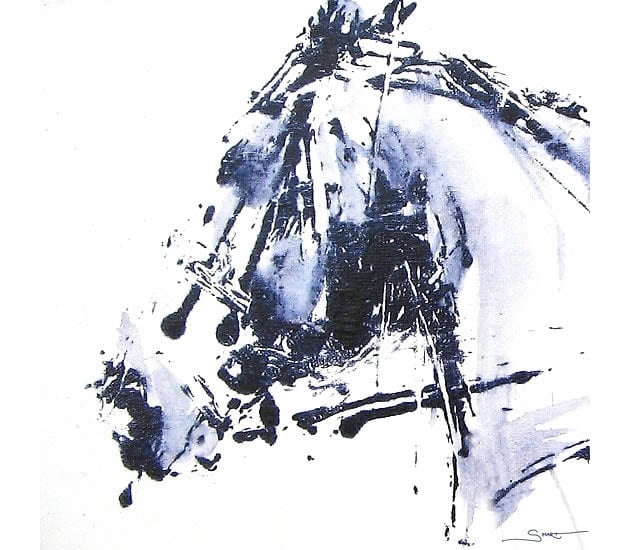
Andy Mercer :

Vital Photography :

Matthew Dunn :

Rod McLaren :

Andreas Fischer :

Nicholas Weltyk :
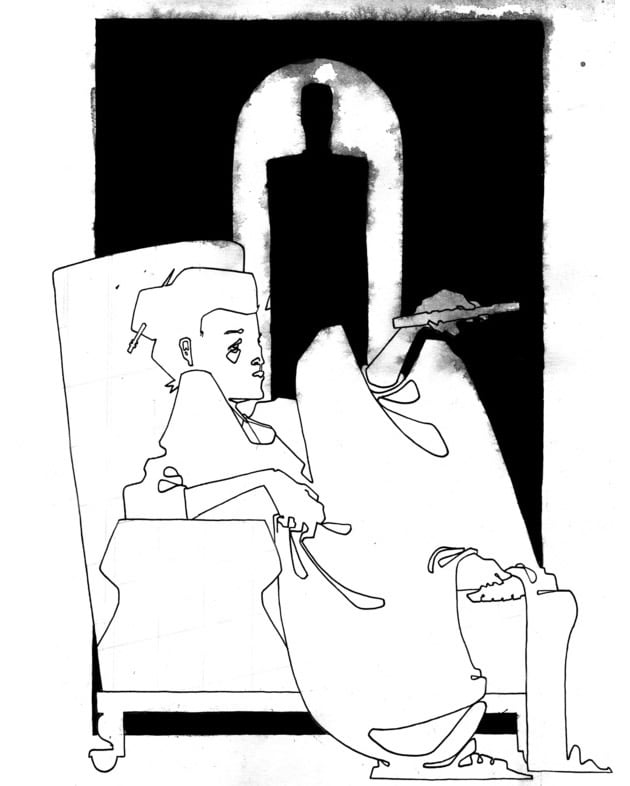
Liliana Porter :

Hong Chun Zhang :
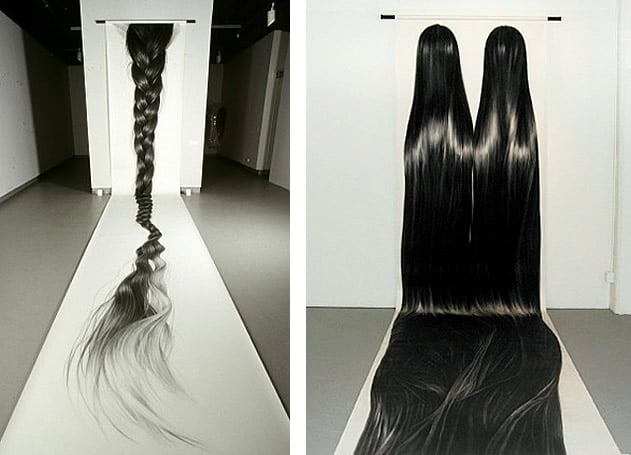
Bruce Pollock :

David Eskenazi

Matt Niebuhr :
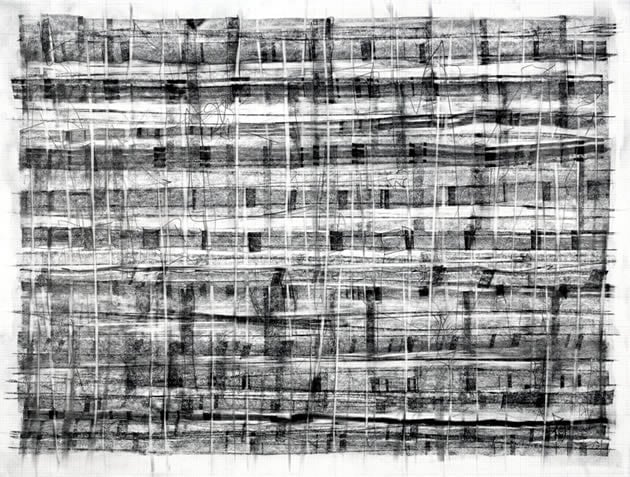
Albrecht Durer :

Victoria Haven :

Carne Griffiths :
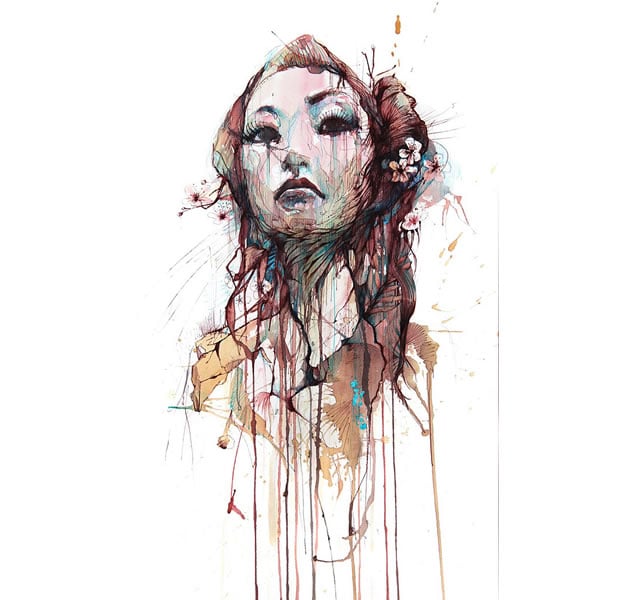
William Anastasi :

Charles Avery

Did you enjoy this article? You may wish to read 11 Tips for Producing an Excellent Observational Drawing .

Amiria has been an Art & Design teacher and a Curriculum Co-ordinator for seven years, responsible for the course design and assessment of student work in two high-achieving Auckland schools. She has a Bachelor of Architectural Studies, Bachelor of Architecture (First Class Honours) and a Graduate Diploma of Teaching. Amiria is a CIE Accredited Art & Design Coursework Assessor.
JOIN OVER 21,000 PEOPLE WHO RECEIVE OUR FREE NEWSLETTER
You will be notified first when free resources are available: Art project ideas, teaching handouts, printable lesson plans, tips and advice from experienced teachers. What are you waiting for?
Email Address*
We send emails monthly. And don’t worry, we hate spam too! Unsubscribe at any time.


- Home Fall 2023-24
- Home January 2023- April 2023
- Home end of 2022 into Fall 2022
- Home Feb-April 2022
- Home-Archive Dec - Feb 2022
- Home-Archive Fall 2021-December 2021
- Home-Archive Spring 2021-October 2021
- Home Archive Fall 2020-March 21
- Home Jan 2020-August 2020
- Home Fall 2019 - Feb 18, 2020
- Home Archive 2018-March 2019
- Home Archive Summer 2018-First Semester 2019
- Home Archive Spring Summer 2018
- Home-Archive January - May 2018
- Home-Archive First Semester 2017-18
- Home-Archive May-August 2017
- Home-Archive Term 4 2017
- Home-Archive Term2/3 2016
- Home-End of Year 2016
- Home Archive Fall 2015- January 5, 2016
- Home Archive December 2016
- Home-Archive May-Aug 2016
- Home-Archive April-May 16
- HomeArchive- Winter - April 2016
- Home-2016 Jan-Feb12 Archive
- Home- Back to School September 2015
- Home-Term 6 2015 Archive through August 10th
- Home-Term 5 Archive Through Sprng Break 2015
- Home-June 2014 Archive
- Home-Term 4 Archive 2015
- Home-Term 3 Archive 2014
- Home-Term Two Archive 2014
- Home-Term One 2014 Archive
- Home-Aug to September 2014 Archive
- Home-March 2014 Archive
- Home-February 2014
- Home January 2014 Archive
- Mindful Matters Through Fiber Arts
- Desperate Times Call for Mark-Making Magic
- Roto What? Get the Scoop on Rotoscope
- Digital Gets Dirty: Alternative Printing Processes in Photography
- Beyond Grades Using Authentic Assessment to Empower Artistic Voice
- Home Archive-Sept-December 2013
- Introduction to Art Assignments
- Unit One: Line
- Unit Two: Positive and Negative Space
- Unit Three: Color
- Unit Four: 3 Dimensional Design-Creature Feature
- AF- Color and Its Meaning
- Unit Five: Digital Self-Portrait
- Sumopaint Digital Self Portrait Assignment
- Unit Six: Clay Vessel
- Unit Seven: Cartooning
- Unit Eight: Reduction Printmaking
- Art Fundamentals Exam Details
- Introduction to Digital Media CH 5 Part 2
- Introduction to Digital Media- Inches to Pixels File Size
- Introduction to Digital Media CH 6 Presentation
- Archive Fall 2016 Introduction to Digital Media Assignments
- Animation-Exp Video Assignments
- Graphic Design Assignments
- Graphic Design Assignments-Archive 2014
- Portrait Research
- Portrait of A Place Boot Camp
- Archive Digital Photography 1 Assignments
- Modern Masters Research
- Digital Photography 2 Light Painters
- Now You See Me Now You Don't
- Digital Illustration
- Drawing 1 Assignments Archive Fall 16/17
- 1st Semester 2015-16-Drawing 1 Assignments
- Painting 1 Assignments
- Drawing 2-Painting 2 Assignments
- Drawing 2/ Painting 2 Alt Media Fiber Arts
- Drawing 2/ Painting 2 Alt Media Encaustic
- Drawing 2/ Painting 2 Collage
- Drawing 2/ Painting 2 Alt Media Alternative Mark-Making-Invented Tool
- Drawing 2-Painting 2-Alt Media-Printmaking
- Drawing 2/ Painting 2 Assignments 2014
- Clay Bust Sculpting Videos
- Wheel Throwing
- Sculpture 2 Assignments
- AP Studio Art Assignments First Semester 2016
- AP Art Alternative Media
- Art History Assignments
- Art History Assignments Archive 15/16
- CA1: Global Prehistory
- CA2: Ancient Mediterranean
- CA3: Early Europe and Colonial Americas
- CA4: Later Europe and Americas
- CA5: Indigenous Americas
- CA6: Africa
- CA7: West and Central Asia
- CA8: South, East, and Southeast Asia
- CA9: The Pacific
- CA10: Global Contemporary
- AP Art History Exam
- Art Club 2023-24
- Art Club Archive 2019-20
- Art Club Archive 2016-17
- Home-Archive Term 5 2017
- Art Club Day of the Dead
- Art Club Archive of 2014-15
- Art Club archive 2013-14
- Travel to Italy
- Digital Photography Wiki Home
- Art College and Career Info
- Pre College and Summer Art Camp
- Scholarships
- Inspirations
- Teacher Resources
- Wiki-Composition and Focus
- Virtual and Online Learning Resources
- A Day in Your Life: Quarantine Realities

- Google Classroom
- Ceramics Syllabus
- Elements and Principles
- Art Criticism
- Peer Critique
- 12 Golden Rules
- Ceramics Box
- Intro to Clay
- One Pinch Pot Animal
- Animal Sculpture
- Decorative/ Free Pinch
- Exposed Coil box with Lid
- Decorative Coil Mug
- Angel Figurine
- Slab Cake Box
- Triptych Coasters
- Monogram Tile
- Free Form Tile
- Cottage Lantern
- DISTANCE LEARNING - ART 1
- Syllabus - Art 1
- UNIT #1 Space
- UNIT #2 Line
- UNIT #3 Value & Form
- Final Semester 1
- UNIT #4 Color
- UNIT #5 Art History
- FINAL SEMESTER 2
- DISTANCE LEARNING ART 2/3
- SYLLABUS - ART 2/3
- Student Survey
- Radial Design
- Personal Identity
- Elements of Art
- Principles of Art
- Elements & Principles Matrix
- What is Art?
- ART TEXT BOOK
- Arttalk - Art in our World
- Arttalk - Aesthetics
- Arttalk - Art Critique
- Tagging VS Graffiti/Street Art
- RHYTHM MATRIX
- Winter Break Reflection
- OPTICAL ILLUSION
- Artist Statement
- Extra Credit Assignments
- Submit Assignments Here
- Contact Info
- CHECK GRADES
- Art Students
- CHALK ART CONTEST
- Student Work
- Digital Assignments
Assignment #1 line exercise
- Mr. Gardner BHS Art
- Art I Vocabulary
- Width - thick, thin, tapering, uneven
- Length - long, short, continuous, broken
- Direction - horizontal, vertical, diagonal, curving, perpendicular, oblique, parallel, radial, zigzag
- Focus - sharp, blurry, fuzzy, choppy
- Feeling - sharp, jagged, gr aceful, smooth
- contour line
- gesture line
- implied line
- calligraphy line
- sketch line
- crosshatching
- line of sight

- all ART-1 lessons
- all classes
- art teacher resource
- art vocabulary
by JuliannaKunstler.com
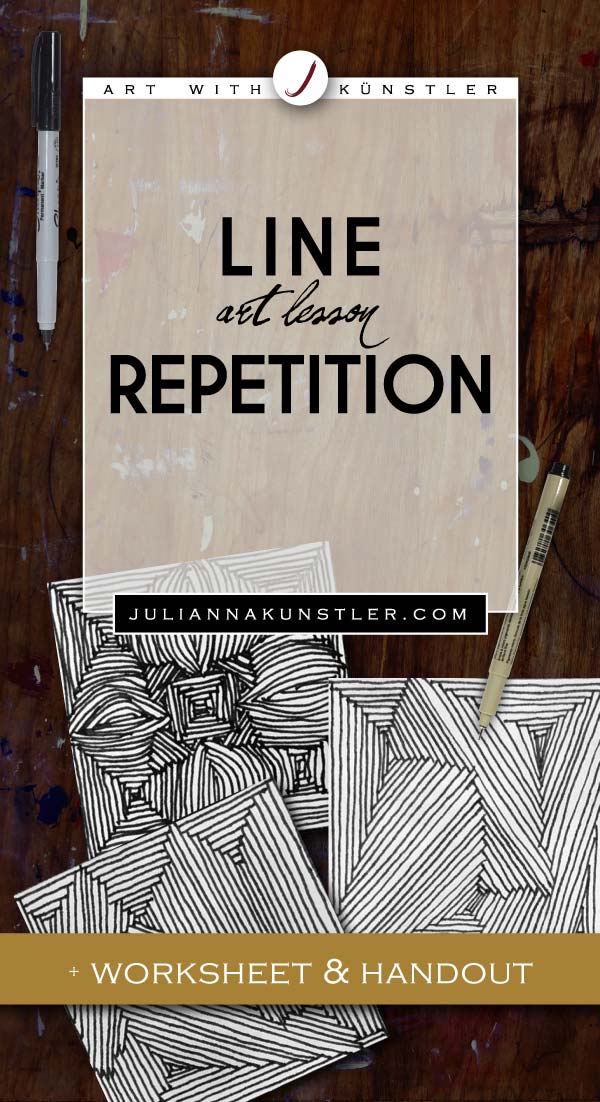
Learning objectives:
- abstract thinking
- critical thinking
- eye-hand coordination
- fine-motor skills
The purpose of this project is to practice the eye-hand coordination.
An important part of learning how to draw is to develop eye-hand coordination skills. It is not as easy as you might think….
Remember, last time you were drawing… you had a perfect picture in your head…. but once you started to draw it… it did not turn out as you have pictured it. Why? Because along with developing drawing skills and techniques, you need to develop a very basic skill – make you hand draw what you have in mind. How we do that? Practice… practice… practice…..
The following exercise will help you to develop this skill. Please note: YOU HAVE TO WORK SLOWLY. Take your time. Learn how to control your own hand. Tame those lines!
Work with a black pen.
materials used:

laserjet paper

Sharpie ultra fine point

worksheet 1: practice
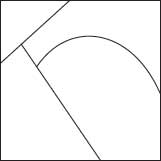
Use worksheet 1 to practice. Follow the steps:
You start with 3-4 random lines inside the square. These can be straight lines or curves. Each line should start and end at the border of the design or another line.
The startup lines should not be loose. Their purpose is to divide a square into enclosed areas..
Now you concentrate on one area at a time.
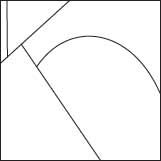
If we pick the top left area first - analyze it.
It has 3 sides.
That means that the lines we are drawing can be only parallel to these 3 sides.
Place your first line parallel to one side.
You start at a line and finish at a line. Do not cross lines.
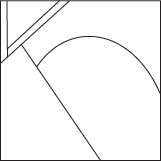
Once you completed the first line - change the direction you are drawing.
Your second line will be parallel to another side.
Get them close together without having them touch (except at the ends).
Once a line touches another line – change the direction.
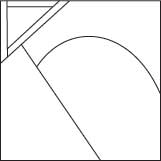
Once you are done with the second line - start the third line, that is going to be parallel to the third side.
You can continue the process "in a circle" - using all sides, or use only select sides of the area, or use only 2 sides
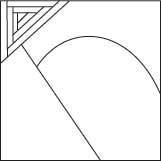
Once you are done with one area – move to the next one.
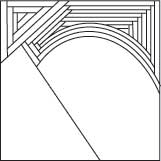
Continue the process until your design is done.
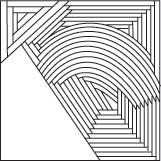
worksheet 2: create
Once you are comfortable with the concept - move on to the next worksheet.
This one is to create your own designs, using the same approach.
You start with 3-4 initial lines to divide a square.
Then fill in each ares with parallel lines following the guidelines.
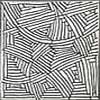
Select your best six.
Cut them out.
Present them on a piece of black board or paper.
Presentation is a part of your grade.
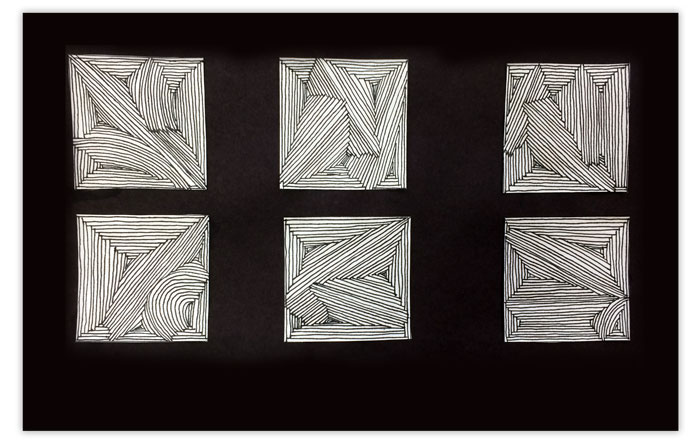

IMAGES
COMMENTS
Sep 1, 2023 · Last Updated on September 1, 2023. When we first picked up a pen or pencil and started making marks on paper, we began with line. Whether self-taught, through trial and error, or guided by others, we learned how line defines form, creates structure, divides a frame, traces contour, creates tonal variation (cross-hatching, for example) and leads the eye from one part of a work to another.
We use line in all art creations at some point or in some degree. Here are just a few examples. Line is used for sketching, gesture and contour drawing. You can create an image with just one line, or make it complex and detailed. Line can be used as the only element in an artwork. Here are some examples of line drawings by Pablo Picasso and ...
Apr 23, 2019 · These cross contour drawings were completed as part of Breadth assignments for AP Studio Art. These drawings show clever use of line thickness, with the line-weight varying in order to create the illusion of tone and show three-dimensional form.
Line Droving Techniques s ort as es cross- atc ins wavy lines hatching stipp ing Ots scribbles www.stuÄentartsuÄe.com I. use a different line technique to fill each of the 12 small boxes. Invent your own techniques to fill the last 6 boxes. Z. use these techniques to apply tone to the geometric objects drawn to the right.
Unit Name: Unit 1- Line-The Most Basic Element of Design Unit Description: Create a series of line drawings that demonstrate your knowledge of line including, blind contour, contour, gesture, open, closed, parallel and varied line. Goal for this unit is to investigate line as an element of art and also to explore varied media used in drawing.
LINE A line is a mark or stroke that is long in proportion to its width. Lines are the fundamental marks used in drawing. There are three uses for line in art: • Contour - used to define edges • Divide space - used to separate areas in an image • Decoration - used to adorn or embellish
Draw lines that represent each emotion. Example: Would a silly line be heavy and bold or light and thin? Would it be short or long? Would it be spiraling or horizontal? Would it be sharp or smooth? Combine all the qualities. For Example: a silly line would be thin, long, spiraling and smooth. So you would draw a thin, long, spiraling, smooth line.
Line of Sight - When an artist arranges the figures in a drawing to face in a direction to guide the viewers eye to other parts of the piece. Edge - Where two colors or surfaces meet. *ASSIGNMENT - Line Type Assignment
Once you completed the first line - change the direction you are drawing. Your second line will be parallel to another side. Get them close together without having them touch (except at the ends). Once a line touches another line – change the direction.
In-Class Assignment Line Exploration In this project we will have several objectives. 1. Create a view finder 2. Explore and experiment with non-representational mark making 3. Find the best compositions then recreate them on a 9x12 piece of paper, first sketching lightly